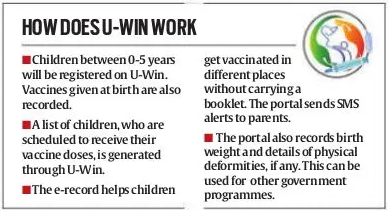Table of Contents
U-WIN Portal
Context: The U-WIN portal is set for a pan-India likely on 15th August.
About U-Win Portal
- It is a replication of the Covid-19 vaccine management system Co-WIN.
- Objective: U-WIN is designed to maintain an electronic registry for routine immunizations, focusing on pregnant women and children under the Universal Immunization Programme (UIP).
- Current Status: The portal is currently being piloted across all states and Union Territories, with the exception of West Bengal.
- Functionality: It meticulously logs each vaccination event for pregnant women and children aged 0-5 years, ensuring vaccines are administered on schedule.

Features
- Accessibility: Citizens can access a QR-based, digitally verifiable e-vaccination certificate similar to the COVID vaccination certificate, available with a single click.
- Comprehensive Record Keeping: U-WIN serves as a central repository for immunisation services, capturing pregnancy details and outcomes, newborn registrations, and immunizations at birth, updating vaccination status and delivery outcomes in real time.
- User Interaction: Through the U-WIN web portal or Android mobile app, citizens can self-register for vaccinations, choose their preferred vaccination centres, and schedule appointments.
- Communication: Automated SMS alerts keep citizens informed about registration confirmations, administered doses, and reminders for upcoming doses.
- Health Record Integration: The platform facilitates the creation of Ayushman Bharat Health Account (ABHA) IDs for comprehensive health record maintenance.
- Support for Healthcare Workers: It aids frontline healthcare workers in digitally recording all vaccination events, ensuring complete, accurate, and easy record maintenance.
Post Harvest Losses
Context: The post-harvest losses of India significantly affected the agricultural production supply.
Current Situation
- Global Rank: India ranks 2nd in global agriculture production.
- Export Share: India’s share in global agricultural exports is only 2.4%, ranking 8th worldwide.
- Post-Harvest Losses in India
- Annual Losses: Approximately ₹1,52,790 crore annually (Ministry of Food Processing Industries 2022 study).
- Perishable Commodities: Largest losses from livestock produce (22%), fruits (19%), and vegetables (18%).
- Export Losses: Around 19% of food is lost during export, especially at the import-country stage.
- Indian Railways Role:
- Accounts for 75% of total earnings from freight, including agricultural produce.
- Food Corporation of India moves 90% of its food grains by rail.
- 97% of fruits and vegetables are transported by road.
What are the Challenges?
- Low Productivity: Affects overall agricultural output and export quality.
- Quality Standards: Inability to meet international quality standards.
- Logistics and Supply Chain Issues:
- Inadequate transportation network and infrastructure.
- Significant post-harvest losses, especially for perishable commodities.
- Small and Marginal Farmers (SMF) Limitations:
- Struggle to achieve economies of scale.
- Lack of assured market connectivity.
- Food Price Volatility: Supply constraints affecting perishable produce.
- Logistical Challenges:
- Multiple touchpoints during transport: farmgate to mandi, long haul transportation (rail, road, water, air), and last mile delivery to consumers..
- Lack of specialised wagons for temperature-controlled transport.
- Awareness and Accessibility: Farmers lack awareness and accessibility to Railway schemes and initiatives.
Indian Railways Initiatives
- Truck-on-Train Service: Carries loaded trucks on railway wagons, with plans for expansion.
- Parcel Special Trains: Introduced during COVID-19 for transporting perishables and seeds.
- Kisan Rail: Connects surplus production regions to consumption regions. For example, grape growers in Nashik earned a net profit of ₹5,000 per quintal using Kisan Rail to transport 22,000 quintals of grapes
Way Forward
- Improve Supply Chain Infrastructure: Invest in transportation networks and rail-side facilities for safe cargo handling.
- Develop specialised wagons for temperature-controlled transport.
- Increase Farmer Awareness and Accessibility:
- Ensure farmers are aware of and have access to Railway schemes.
- Provide training and support for efficient use of transportation services.
- Focus on Efficiency: As per the recommendations of Doubling of Farmers Income (DFI) committee:
- Streamline loading and unloading processes to minimise transit times.
- Address staffing shortages through recruitment and training initiatives.
- Prioritise railways over roadways for the transportation of fruits and vegetables.
- Support Small and Marginal Farmers:
- Provide market connectivity and support to achieve economies of scale.
- Enhance access to infrastructure and logistical support.
- Promote Sustainable Practices:
- Leverage rail transport to reduce carbon emissions and promote environmental sustainability.
- Implement a systems-based approach that integrates various modes of transport and geographies.
- Public-Private Partnerships: Enhance operational efficiency and strengthen rail infrastructure.
- Budgetary Allocation for Agriculture 2024: Aims to bridge the farm-to-market gap with modern infrastructure and value-addition support.
Examples Case Studies and Data
- Social Justice and Welfare Measures (GS 2): Under ‘Operation Nanhe Farishtey,’ 84,119 children were rescued.
- This mission is focused on saving children who require care and protection across different zones of the Indian Railways.


 Topological Materials: The Future of Qua...
Topological Materials: The Future of Qua...
 China’s Deep Sea Station in South Chin...
China’s Deep Sea Station in South Chin...
 Project ICE-CRUNCH: India-Switzerland Co...
Project ICE-CRUNCH: India-Switzerland Co...





















